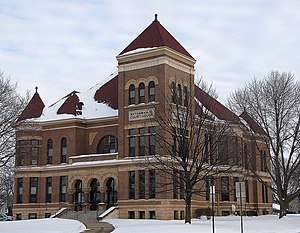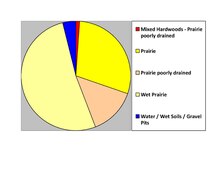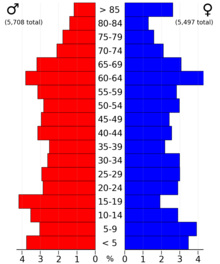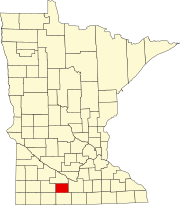Watonwan County, Minnesota
Watonwan County | |
|---|---|
 | |
 Location within the U.S. state of Minnesota | |
 Minnesota's location within the U.S. | |
| Coordinates: 43°59′N 94°37′W / 43.98°N 94.61°W | |
| Country | |
| State | |
| Founded | February 25, 1860[1] |
| Named for | Watonwan River |
| Seat | St. James |
| Largest city | St. James |
| Area | |
| • Total | 440 sq mi (1,100 km2) |
| • Land | 435 sq mi (1,130 km2) |
| • Water | 4.8 sq mi (12 km2) 1.1% |
| Population (2020) | |
| • Total | 11,253 |
| • Estimate (2023) | 11,077 |
| • Density | 25.9/sq mi (10.0/km2) |
| Time zone | UTC−6 (Central) |
| • Summer (DST) | UTC−5 (CDT) |
| Congressional district | 1st |
| Website | www |
Watonwan County is a county in the U.S. state of Minnesota. As of the 2020 census, the population was 11,253.[2] Its county seat is St. James.[3]
History
[edit]In 1849, the new territorial legislature of the recently organized Minnesota Territory authorized the creation of nine large counties across the Territory. Four years later in 1853, one of those original counties of Dakota, had a large area separated and partitioned off to create Blue Earth County. Less than only two years later, by 1855, the western part of Blue Earth was then partitioned to create Brown County. Again, after five years on February 25, 1860, the southern part of Brown was partitioned to create this county of Watanwan, with the town of Madelia as the original designated County Seat. The county was named for its eponymous river, (Watonwan River, which flows into the Blue Earth River, then the Minnesota River, then eventually into the "Father of Waters" - the Mississippi River, which drains the entire middle of the North American continent), whose name reflects the Dakota native word "watanwan," meaning "fish bait" or "plenty of fish."[4] The word first appears in the modern written record on an 1843 map of the area so naming the river.
In 1869, the first European white settlers arrived in the area of the future town of Saint James, and the area began growing. In the next year of 1870 an extension of the St. Paul and Sioux City Railway was terminated at the village, and railway officials decided to name the terminus Saint James. By 1878, that town had grown to the extent that a vote was taken in the county to move the county seat and courthouse there from Madelia .[5]
Geography
[edit]
The terrain of Watonwan County consists of low rolling hills, carved by drainages and dotted with lakes and ponds. The area is completely devoted to agriculture where possible.[7] The terrain slopes to the north and east, with its highest point near its southwest corner, at 1,293 ft (394 m) ASL.[8] The county has an area of 440 square miles (1,100 km2), of which 435 square miles (1,130 km2) is land and 4.8 square miles (12 km2) (1.1%) is water.[9] The county is drained by the Watonwan River and its tributaries; the river flows eastward through the northern part of the county.[10]
Major highways
[edit]Airports
[edit]- St. James Municipal Airport (JYG, LID) - 3 miles (4.8 km) east of St. James
Adjacent counties
[edit]- Brown County - north
- Blue Earth County - east
- Martin County - south
- Jackson County - southwest
- Cottonwood County - west
Protected areas
[edit]- Bergdahl State Wildlife Management Area
- Lewisville State Wildlife Management Area
- Turtle Marsh State Wildlife Management Area
- Wilson State Wildlife Management Area
- Woodlake State Wildlife Management Area
Lakes
[edit]- Bergdahl Lake
- Bullhead Lake
- Butterfield Lake
- Case Lake
- Cottonwood Lake
- Ewy Lake
- Fedji Lake
- Irish Lake
- Long Lake
- Mary Lake
- Mud Lake
- Kansas Lake
- Saint James Lake
- School Lake
- Sulem Lake
- Wilson Lake ("School Lake" in some records)
- Wood Lake (part)
Demographics
[edit]| Census | Pop. | Note | %± |
|---|---|---|---|
| 1870 | 2,426 | — | |
| 1880 | 5,104 | 110.4% | |
| 1890 | 7,746 | 51.8% | |
| 1900 | 11,496 | 48.4% | |
| 1910 | 11,332 | −1.4% | |
| 1920 | 12,457 | 9.9% | |
| 1930 | 12,802 | 2.8% | |
| 1940 | 13,902 | 8.6% | |
| 1950 | 13,881 | −0.2% | |
| 1960 | 14,460 | 4.2% | |
| 1970 | 13,298 | −8.0% | |
| 1980 | 12,361 | −7.0% | |
| 1990 | 11,682 | −5.5% | |
| 2000 | 11,876 | 1.7% | |
| 2010 | 11,211 | −5.6% | |
| 2020 | 11,253 | 0.4% | |
| 2023 (est.) | 11,077 | [11] | −1.6% |
| U.S. Decennial Census[12] 1790-1960[13] 1900-1990[14] 1990-2000[15] 2010-2020[2] | |||
2020 United States Decenial Census
[edit]| Race | Num. | Perc. |
|---|---|---|
| White (NH) | 7,689 | 68.33% |
| Black or African American (NH) | 42 | 0.37% |
| Native American (NH) | 13 | 0.12% |
| Asian (NH) | 86 | 0.76% |
| Pacific Islander (NH) | 0 | 0% |
| Other/Mixed (NH) | 196 | 1.74% |
| Hispanic or Latino | 3,227 | 28.7% |
Previous 2000 United States Decenial Census
[edit]
As of the United States Decenial census of 2000, there were 11,876 people, 4,627 households, and 3,141 families in the county. The population density was 27.3 per square mile (10.5/km2). There were 5,036 housing units at an average density of 11.6 per square mile (4.5/km2). The racial makeup of the county was 88.54% White, 0.37% Black or African American, 0.21% Native American, 0.87% Asian, 0.02% Pacific Islander, 8.78% from other races, and 1.21% from two or more races. 15.19% of the population were Hispanic or Latino of any race. 40.9% were of German, 17.3% Norwegian and 5.8% Swedish ancestry.
There were 4,627 households, out of which 32.50% had children under the age of 18 living with them, 56.60% were married couples living together, 7.30% had a female householder with no husband present, and 32.10% were non-families. 28.70% of all households were made up of individuals, and 15.40% had someone living alone who was 65 years of age or older. The average household size was 2.53 and the average family size was 3.10.
The county population contained 27.60% under the age of 18, 7.80% from 18 to 24, 24.30% from 25 to 44, 21.70% from 45 to 64, and 18.60% who were 65 years of age or older. The median age was 39 years. For every 100 females there were 95.40 males. For every 100 females age 18 and over, there were 94.50 males.
The median income for a household in the county was $35,441, and the median income for a family was $42,321. Males had a median income of $29,242 versus $19,788 for females. The per capita income for the county was $16,413. About 7.80% of families and 9.80% of the population were below the poverty line, including 13.50% of those under age 18 and 8.80% of those age 65 or over.
Communities
[edit]Cities
[edit]- Butterfield
- Darfur
- La Salle
- Lewisville
- Madelia
- Odin
- Ormsby (partly in Martin County)
- St. James (county seat)
Unincorporated communities
[edit]- Echols
- Godahl (partial)
- Grogan
- South Branch
- Sveadahl
- Tenmile Corner
Townships
[edit]Government and politics
[edit]Watonwan County has had its county seat and site of the Watonwan County Courthouse in the town of St. James, Minnesota since 1878, when it was moved from nearby Madelia where it had been located since the partition of the county from Brown County. Watowan's public citizenry of voters have tended to vote for the Republican Party; in two-thirds of the past 11 presidential elections years since 1980, the majority of county voters had selected the Republican Party's presidential and vice presidential nominees (as of 2020). But there are active party organizations and groups for both Republican, Democratic / Farmer-Labor and independent unaffiliated voting citizens of both conservative and liberal / progressive views.
| Year | Republican | Democratic | Third party(ies) | |||
|---|---|---|---|---|---|---|
| No. | % | No. | % | No. | % | |
| 2020 | 3,103 | 59.66% | 1,987 | 38.20% | 111 | 2.13% |
| 2016 | 2,768 | 55.38% | 1,814 | 36.29% | 416 | 8.32% |
| 2012 | 2,517 | 48.93% | 2,494 | 48.48% | 133 | 2.59% |
| 2008 | 2,526 | 48.04% | 2,562 | 48.73% | 170 | 3.23% |
| 2004 | 2,970 | 53.20% | 2,514 | 45.03% | 99 | 1.77% |
| 2000 | 2,562 | 49.90% | 2,258 | 43.98% | 314 | 6.12% |
| 1996 | 1,997 | 37.74% | 2,534 | 47.89% | 760 | 14.36% |
| 1992 | 1,871 | 33.54% | 2,100 | 37.65% | 1,607 | 28.81% |
| 1988 | 2,821 | 52.10% | 2,544 | 46.98% | 50 | 0.92% |
| 1984 | 3,526 | 58.98% | 2,425 | 40.57% | 27 | 0.45% |
| 1980 | 3,629 | 55.09% | 2,442 | 37.07% | 516 | 7.83% |
| 1976 | 3,351 | 50.30% | 3,177 | 47.69% | 134 | 2.01% |
| 1972 | 3,960 | 63.35% | 2,229 | 35.66% | 62 | 0.99% |
| 1968 | 3,446 | 53.57% | 2,701 | 41.99% | 286 | 4.45% |
| 1964 | 2,823 | 43.80% | 3,615 | 56.09% | 7 | 0.11% |
| 1960 | 4,173 | 63.28% | 2,412 | 36.57% | 10 | 0.15% |
| 1956 | 3,963 | 67.62% | 1,886 | 32.18% | 12 | 0.20% |
| 1952 | 4,549 | 72.02% | 1,752 | 27.74% | 15 | 0.24% |
| 1948 | 2,581 | 45.30% | 3,039 | 53.33% | 78 | 1.37% |
| 1944 | 3,146 | 57.27% | 2,324 | 42.31% | 23 | 0.42% |
| 1940 | 3,478 | 55.30% | 2,783 | 44.25% | 28 | 0.45% |
| 1936 | 1,930 | 33.44% | 3,668 | 63.55% | 174 | 3.01% |
| 1932 | 1,919 | 39.62% | 2,795 | 57.71% | 129 | 2.66% |
| 1928 | 3,306 | 69.69% | 1,412 | 29.76% | 26 | 0.55% |
| 1924 | 2,297 | 53.57% | 279 | 6.51% | 1,712 | 39.93% |
| 1920 | 3,510 | 81.40% | 647 | 15.00% | 155 | 3.59% |
| 1916 | 1,300 | 59.94% | 801 | 36.93% | 68 | 3.14% |
| 1912 | 254 | 12.22% | 618 | 29.74% | 1,206 | 58.04% |
| 1908 | 1,411 | 70.44% | 537 | 26.81% | 55 | 2.75% |
| 1904 | 1,455 | 79.95% | 307 | 16.87% | 58 | 3.19% |
| 1900 | 1,509 | 71.93% | 509 | 24.26% | 80 | 3.81% |
| 1896 | 1,622 | 71.99% | 586 | 26.01% | 45 | 2.00% |
| 1892 | 934 | 62.68% | 388 | 26.04% | 168 | 11.28% |
| Position | Name | District | Next election | |
|---|---|---|---|---|
| Commissioner | Jim Pettersen | District 1 | 2024 | |
| Commissioner | Bill Miller | District 2 | 2026 | |
| Commissioner | Jim Branstad | District 3 | 2024 | |
| Commissioner | Scott Westerman | District 4 | 2026 | |
| Commissioner | Dillon Melheim | District 5 | 2024 | |
| Position | Name | Affiliation | District | |
|---|---|---|---|---|
| Senate | Julie Rosen[19] | Republican | District 23 | |
| House of Representatives | Bjorn Olson[20] | Republican | District 23A | |
| House of Representatives | Jeremy Munson[21] | Republican | District 23B | |
| Position | Name | Affiliation | District | |
|---|---|---|---|---|
| House of Representatives | Brad Finstad[22] | Republican | 1st | |
| Senate | Amy Klobuchar[23] | Democrat | N/A | |
| Senate | Tina Smith[24] | Democrat | N/A | |
See also
[edit]Footnotes
[edit]- ^ "Minnesota Place Names". Minnesota Historical Society. Retrieved March 19, 2014.
- ^ a b "State & County QuickFacts". United States Census Bureau. Retrieved April 20, 2023.
- ^ "Find a County". National Association of Counties. Retrieved June 7, 2011.
- ^ Chicago and North Western Railway Company (1908). A History of the Origin of the Place Names Connected with the Chicago & North Western and Chicago, St. Paul, Minneapolis & Omaha Railways. p. 165.
- ^ Upham, Warren. Minnesota Geographic Names (1920), pp. 547-76 (accessed April 22, 2019)
- ^ Nelson, Steven (2011). Savanna Soils of Minnesota. Minnesota: Self. pp. 65-67. ISBN 978-0-615-50320-2.
- ^ a b c Watonwan County MN Google Maps (accessed April 22, 2019)
- ^ "Find an Altitude/Watonwan County MN" Google Maps (accessed April 22, 2019)
- ^ "2010 Census Gazetteer Files". United States Census Bureau. August 22, 2012. Archived from the original on October 6, 2014. Retrieved October 25, 2014.
- ^ Minnesota Atlas & Gazetteer. Yarmouth ME: DeLorme. 1994. pp. 21–22. ISBN 0-89933-222-6.
- ^ "Annual Estimates of the Resident Population for Counties: April 1, 2020 to July 1, 2023". Retrieved March 18, 2024.
- ^ "U.S. Decennial Census". United States Census Bureau. Retrieved October 25, 2014.
- ^ "Historical Census Browser". University of Virginia Library. Retrieved October 25, 2014.
- ^ "Population of Counties by Decennial Census: 1900 to 1990". United States Census Bureau. Retrieved October 25, 2014.
- ^ "Census 2000 PHC-T-4. Ranking Tables for Counties: 1990 and 2000" (PDF). United States Census Bureau. Archived (PDF) from the original on March 27, 2010. Retrieved October 25, 2014.
- ^ "P2 HISPANIC OR LATINO, AND NOT HISPANIC OR LATINO BY RACE – 2020: DEC Redistricting Data (PL 94-171) – Watonwan County, Minnesota".
- ^ Leip, David. "Atlas of US Presidential Elections". uselectionatlas.org. Retrieved October 10, 2018.
- ^ "County Board of Commissioners | Watonwan County, MN - Official Website". www.co.watonwan.mn.us. Retrieved April 25, 2023.
- ^ "MN State Senate". www.senate.mn. Retrieved June 26, 2020.
- ^ "Rep. Bjorn Olson (23A) - Minnesota House of Representatives". www.house.leg.state.mn.us. Retrieved April 19, 2021.
- ^ "Rep. Jeremy Munson (23B) - Minnesota House of Representatives". www.house.leg.state.mn.us. Retrieved June 26, 2020.
- ^ "Republican Rep. Brad Finstad sworn in to finish Hagedorn's House term". August 12, 2022.
- ^ "U.S. Senator Amy Klobuchar". www.klobuchar.senate.gov. Retrieved June 24, 2020.
- ^ "Home". Senator Tina Smith. Retrieved June 24, 2020.
Further reading
[edit]- John A. Brown (ed.), History of Cottonwood and Watonwan counties, Minnesota: Their People, Industries, and Institutions: With Biographical Sketches of Representative Citizens and Genealogical Records of Many of the Old Families. In Two Volumes. Indianapolis, IN: B.F. Bowen and Company, 1916. Volume 1 | Volume 2

